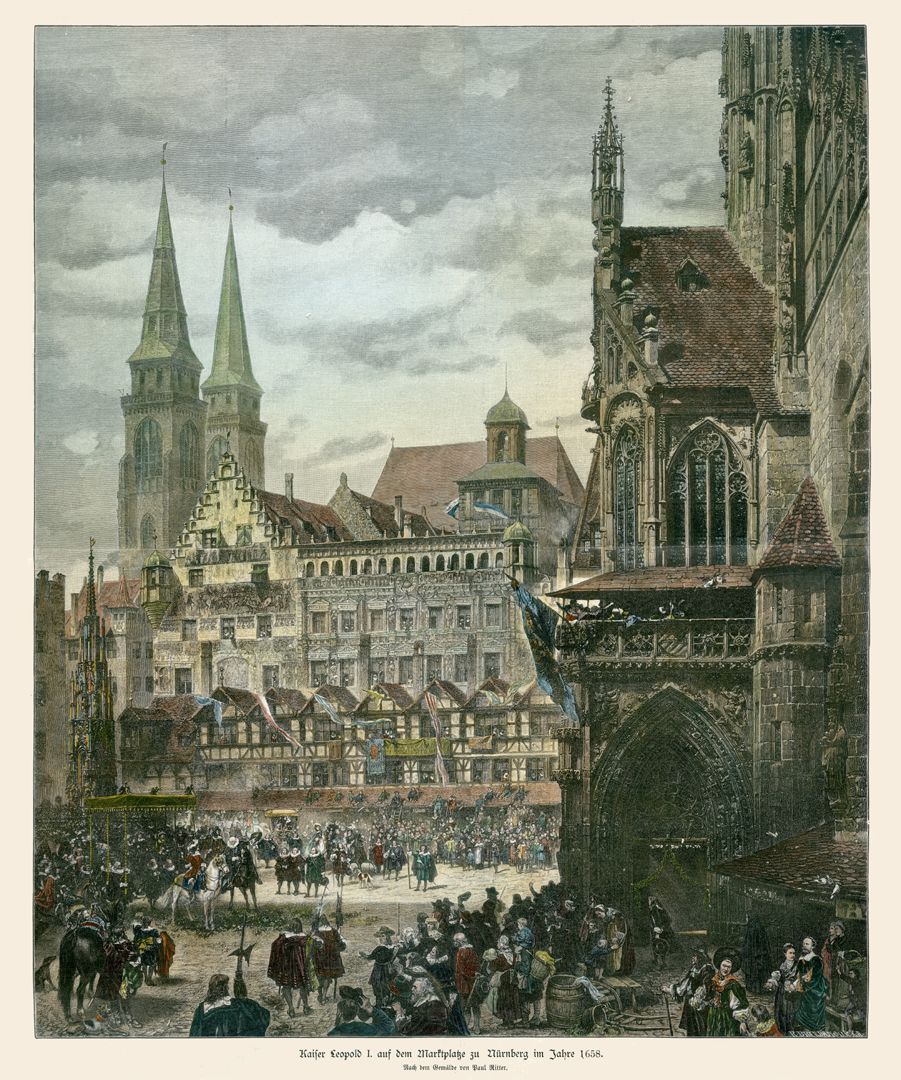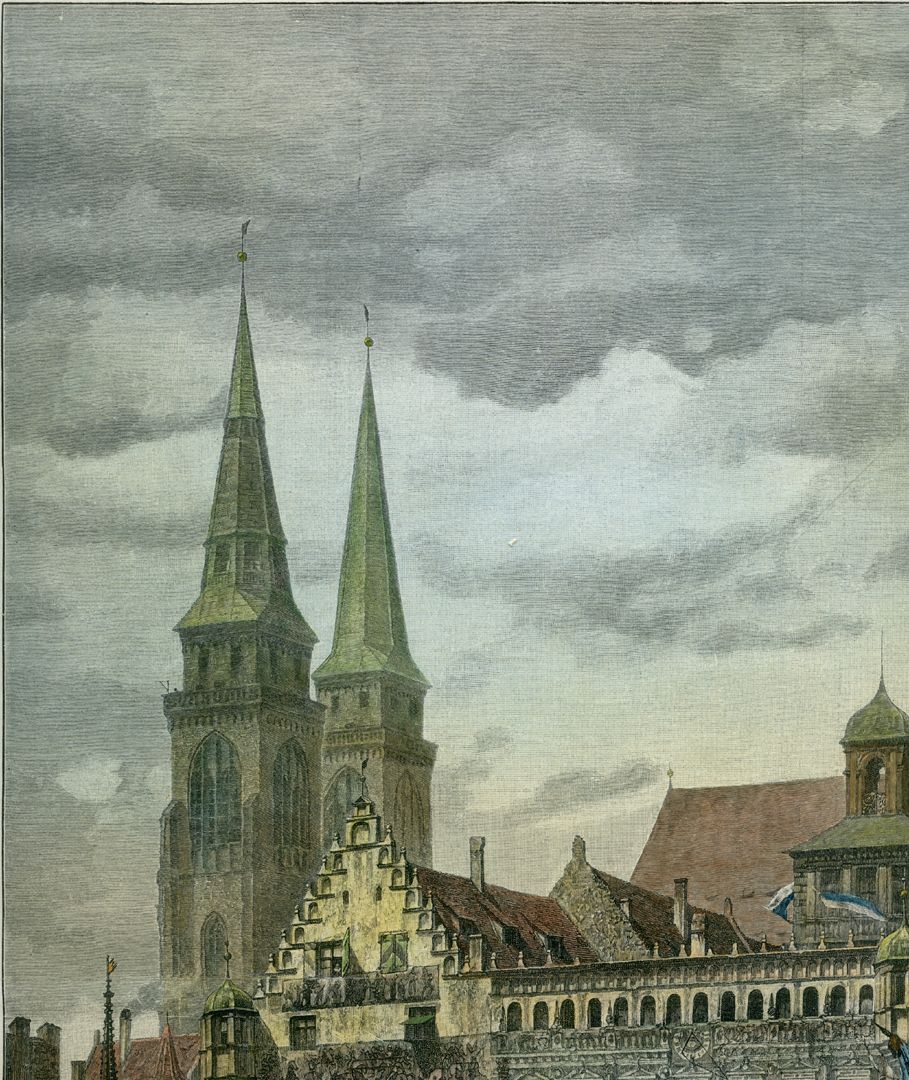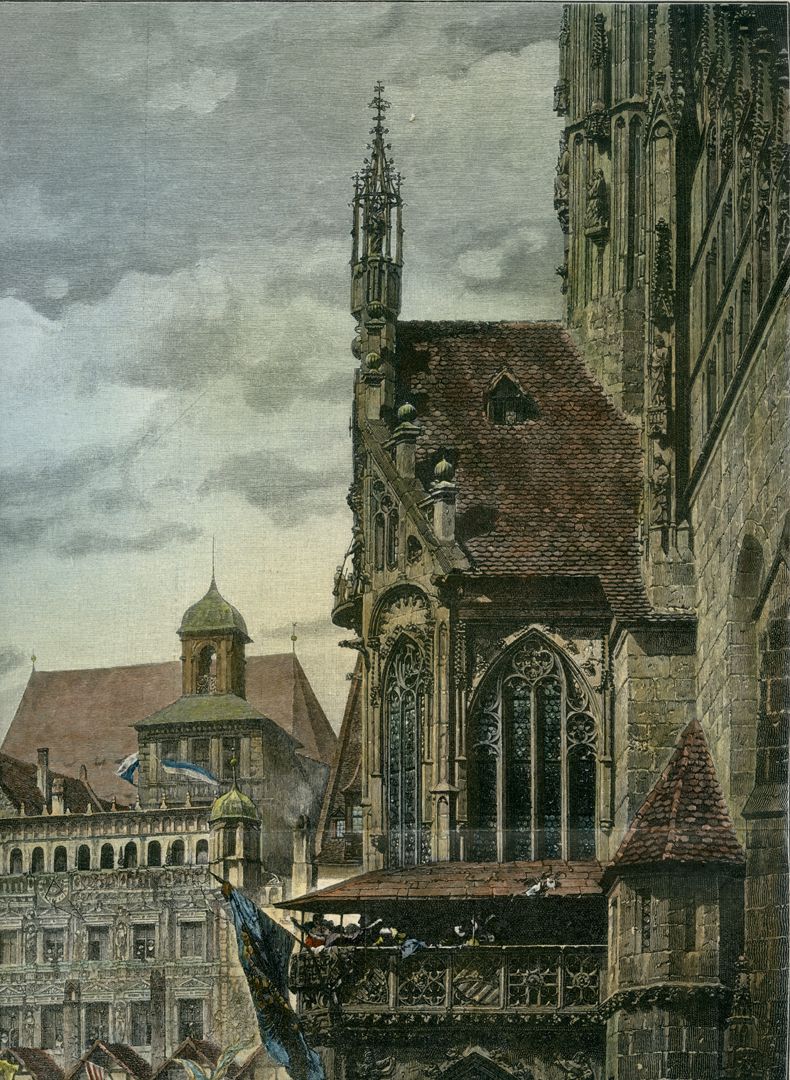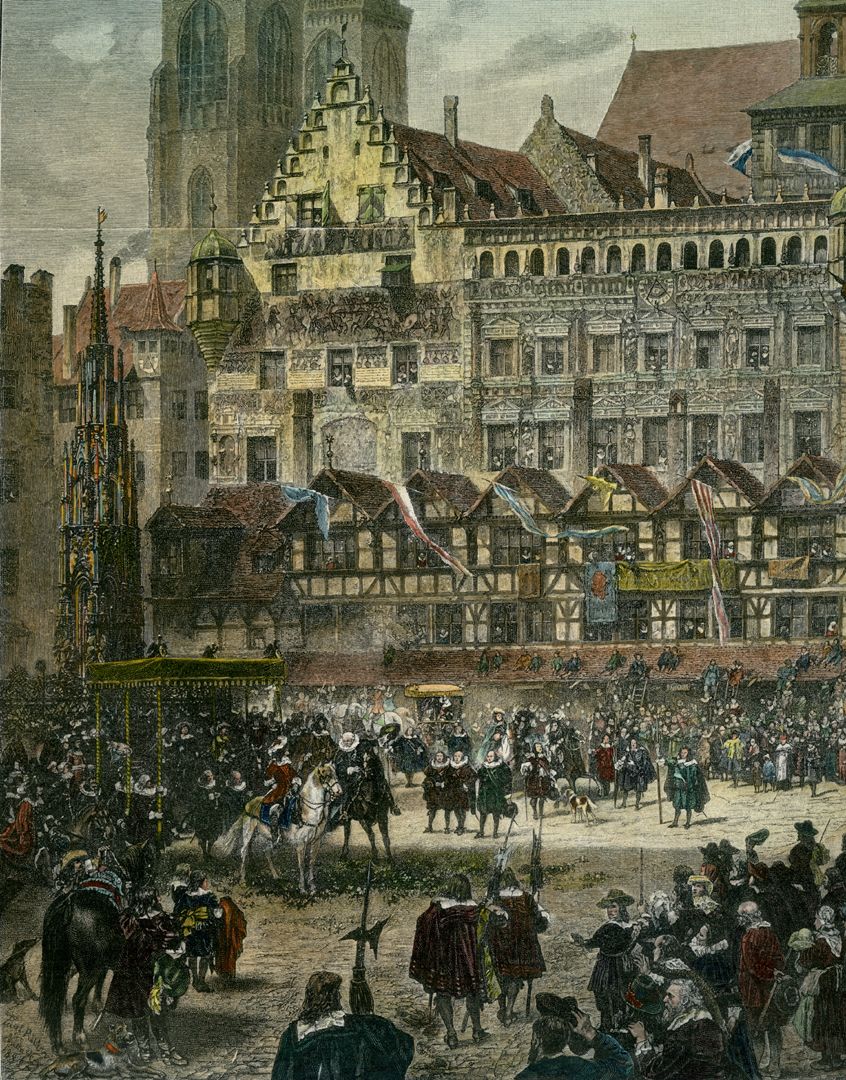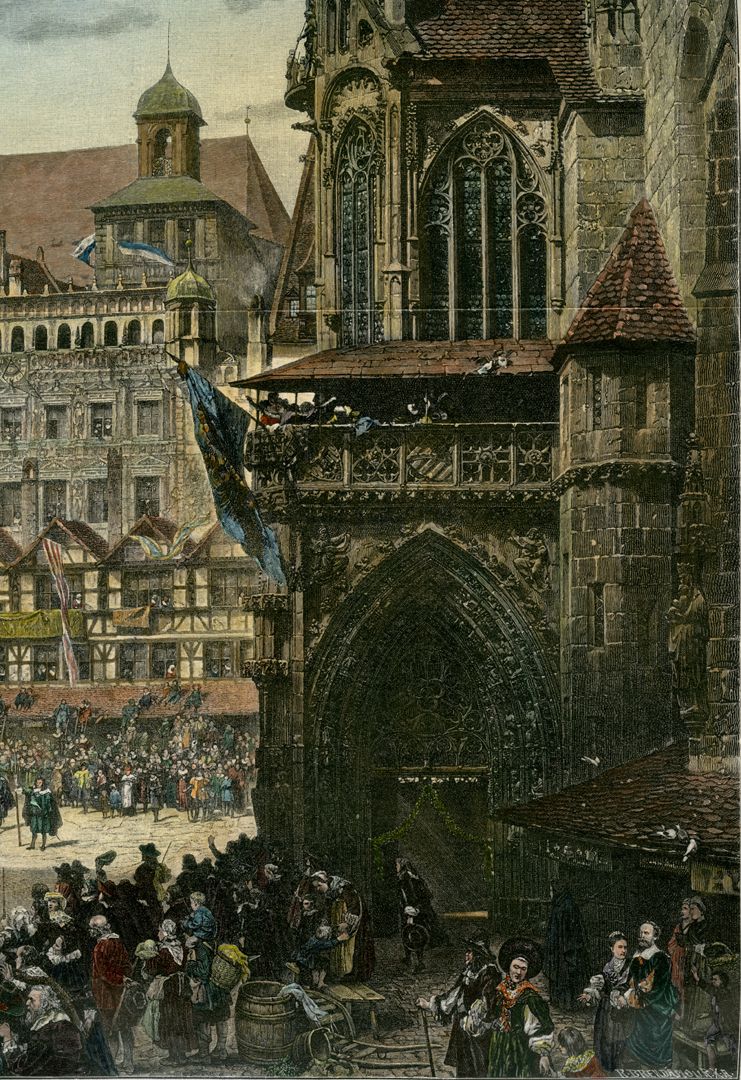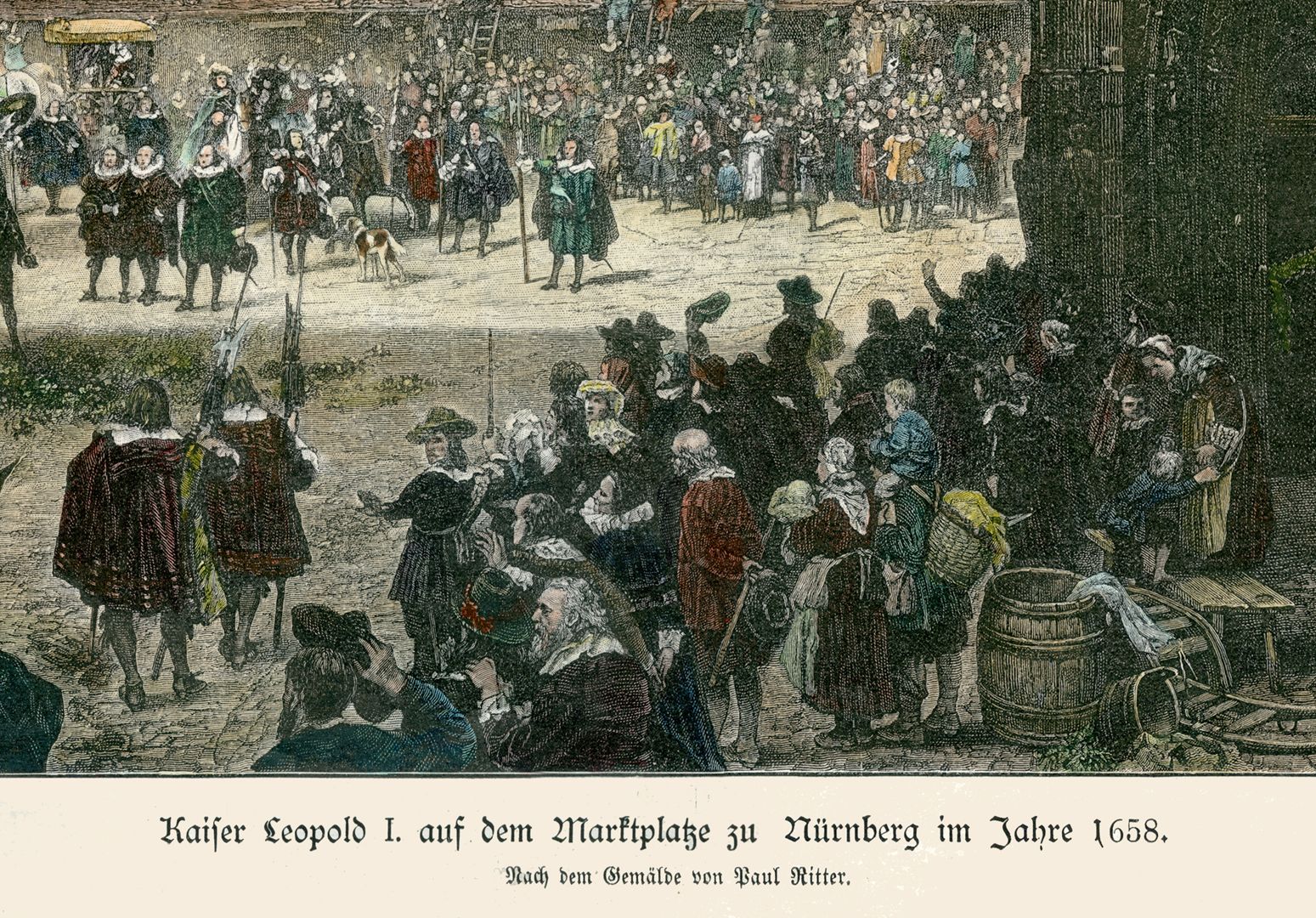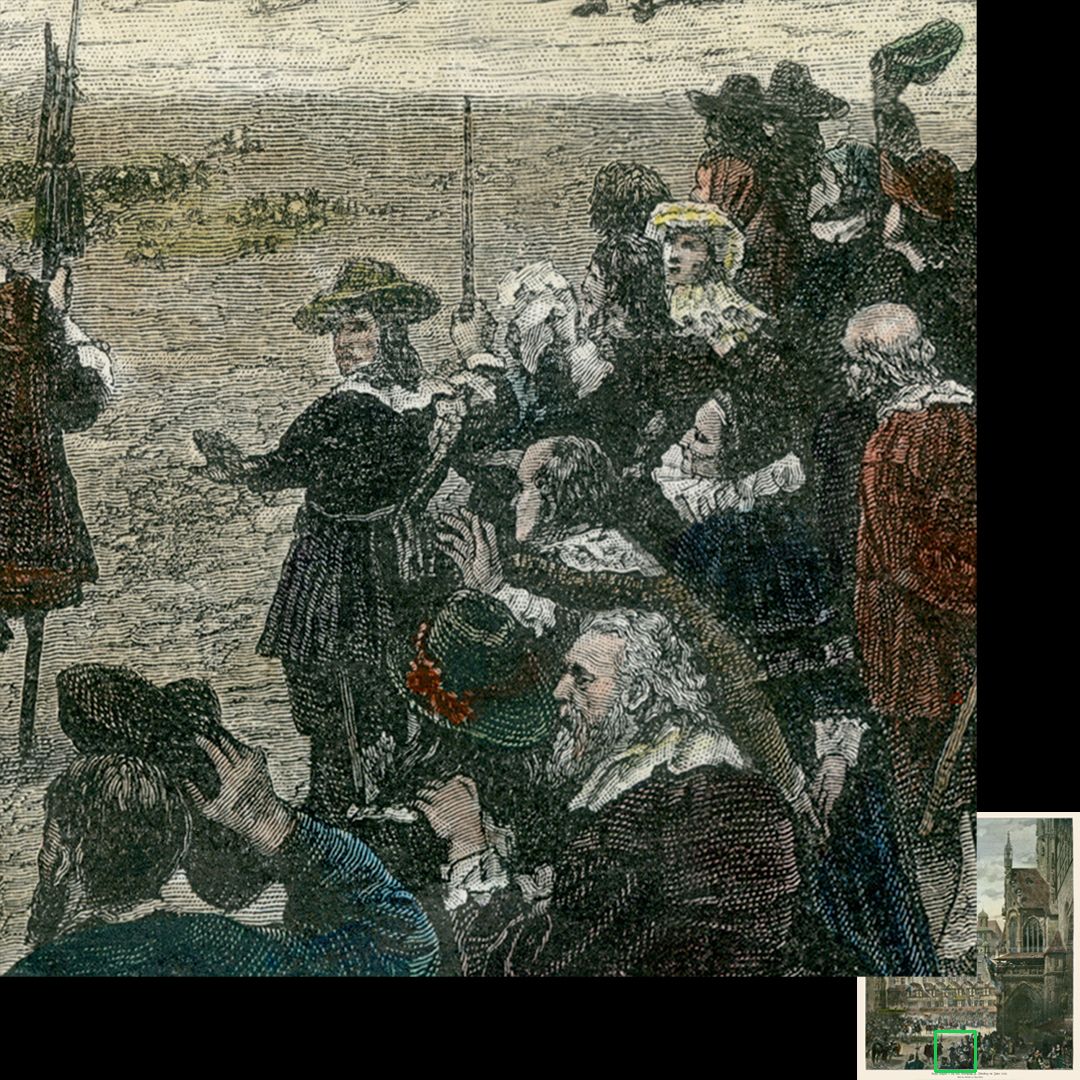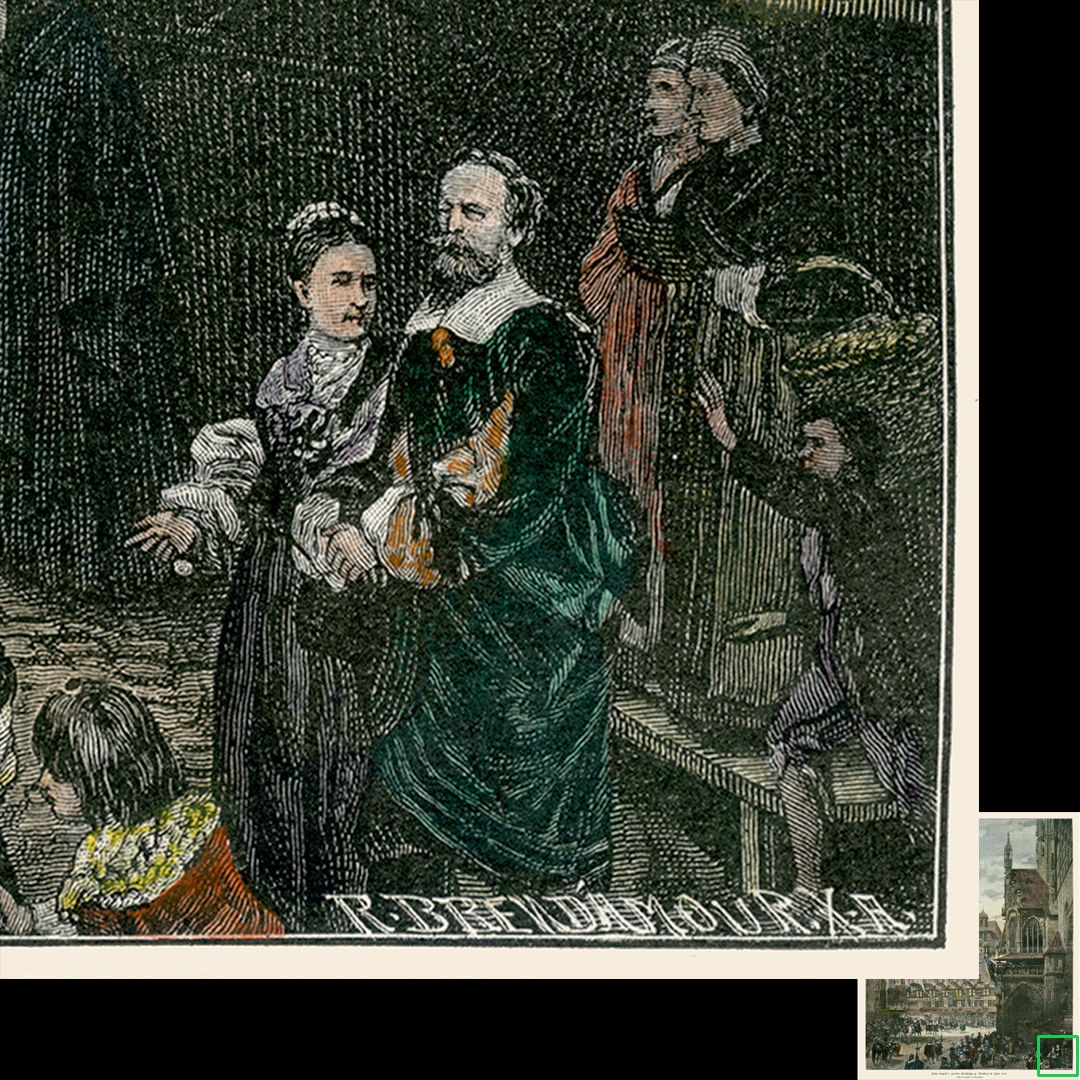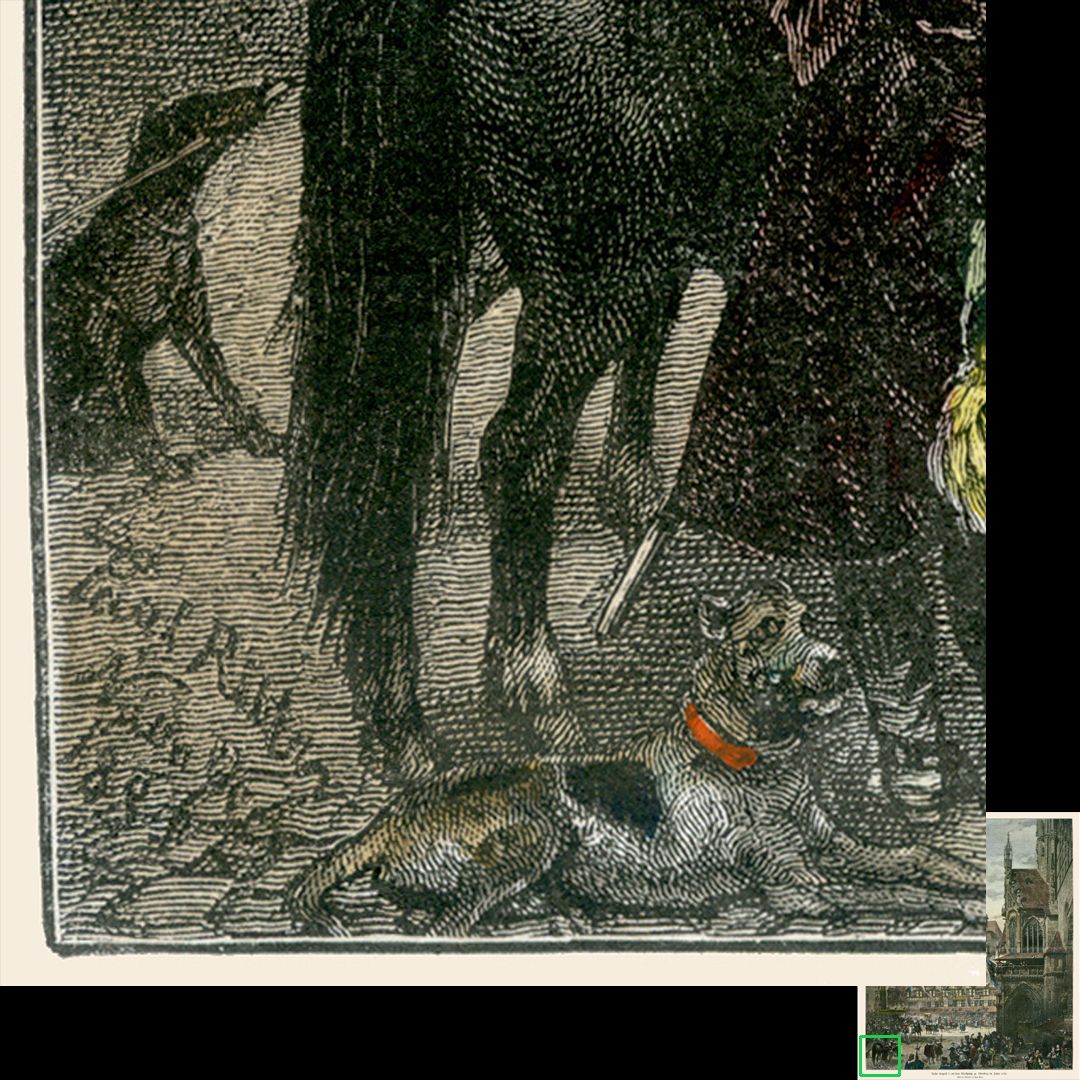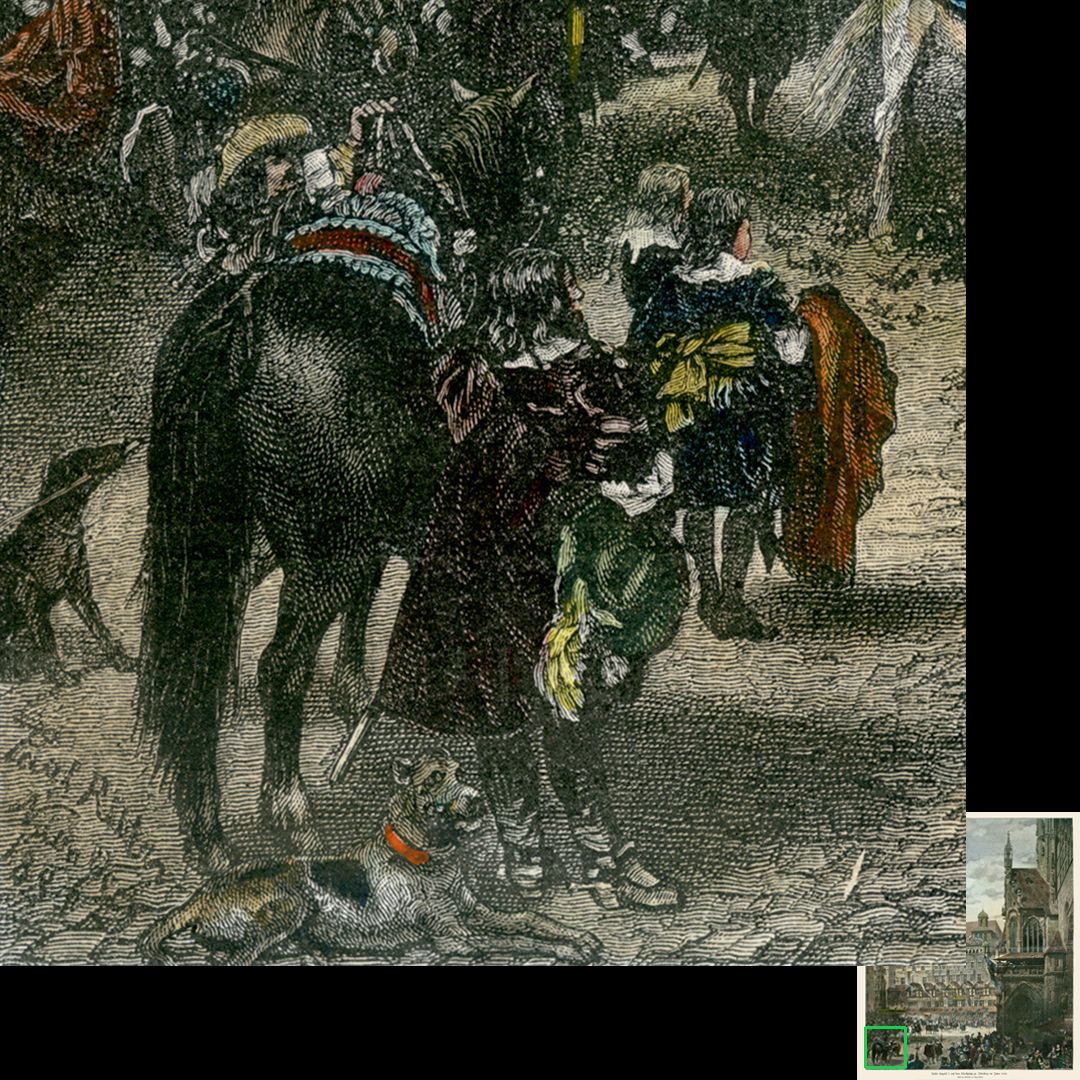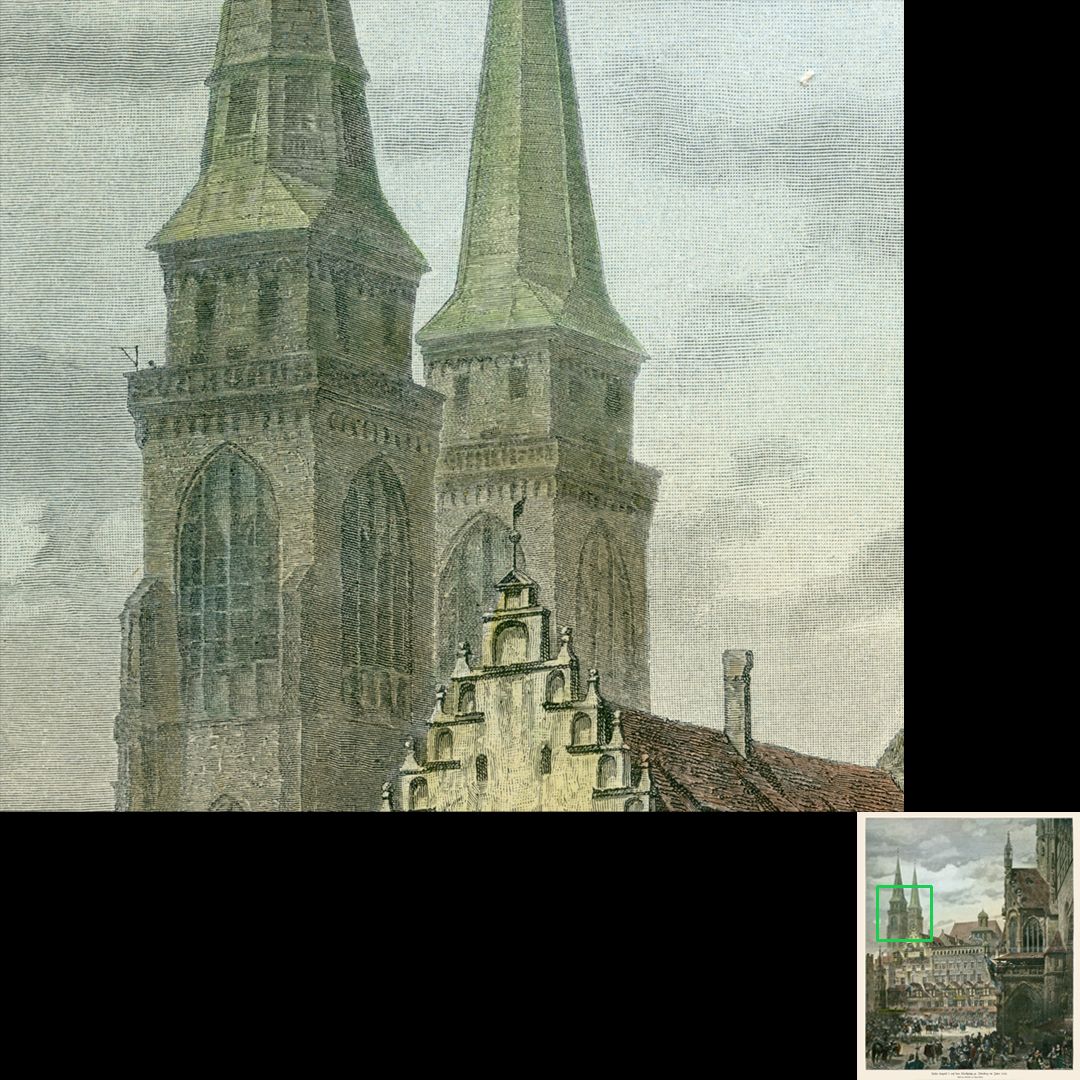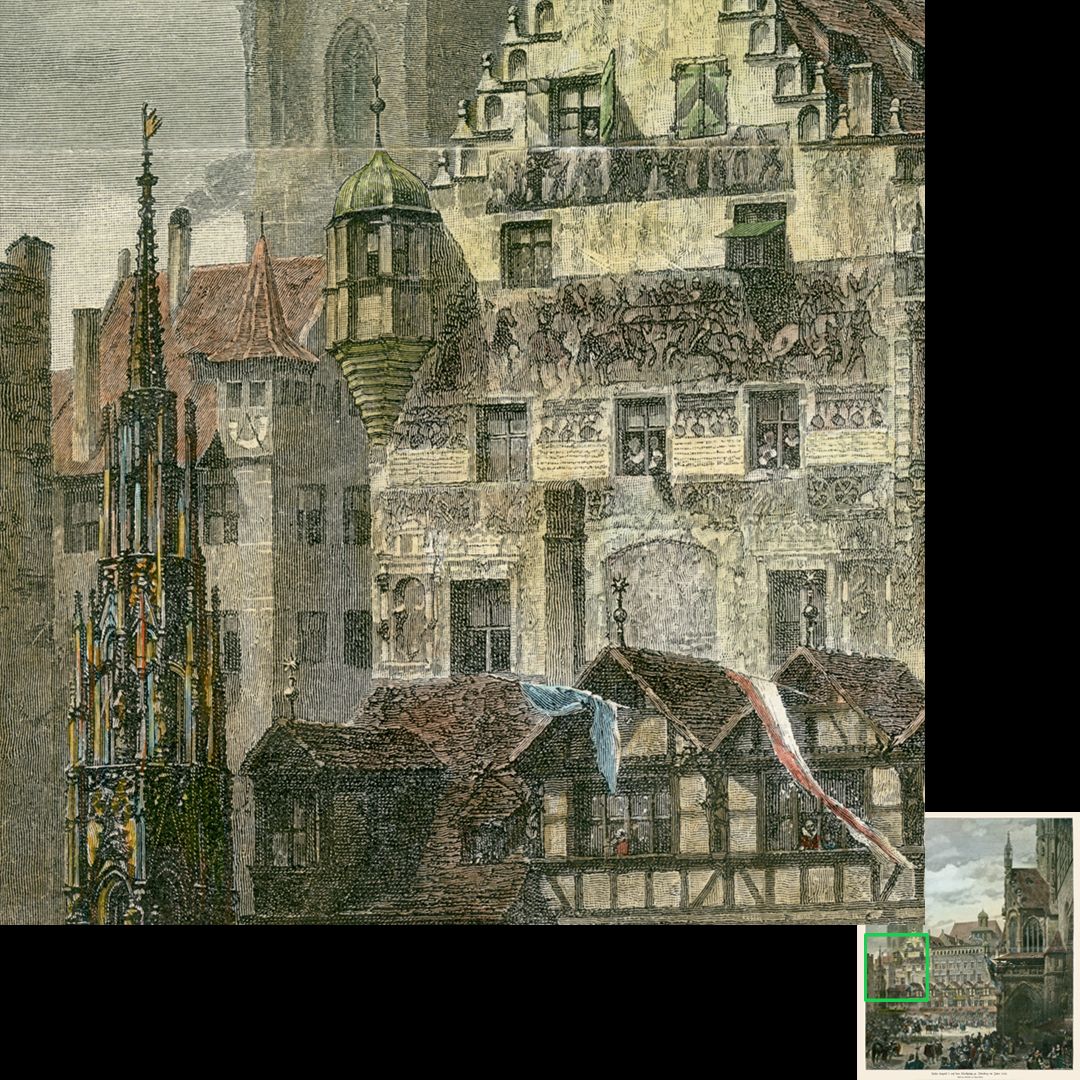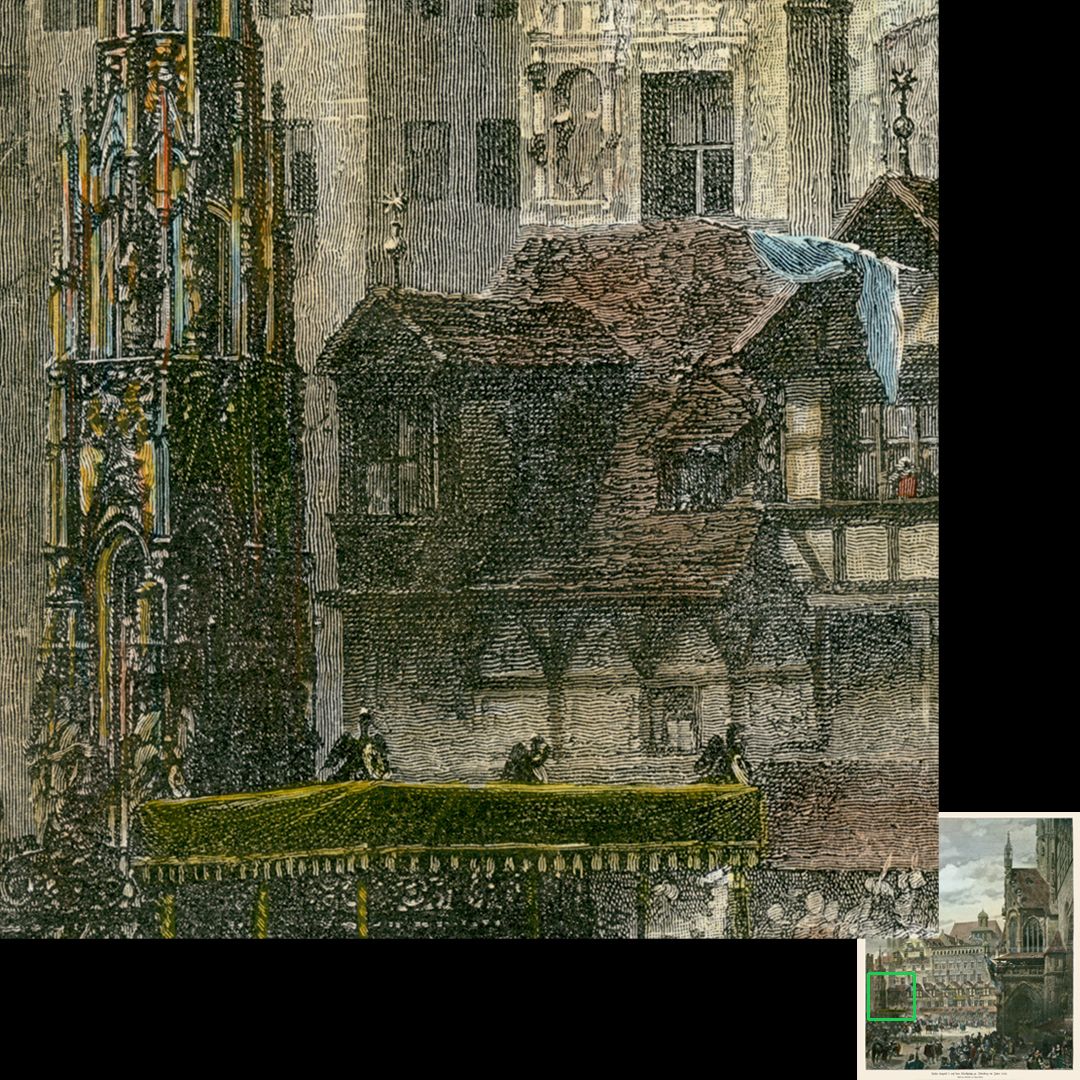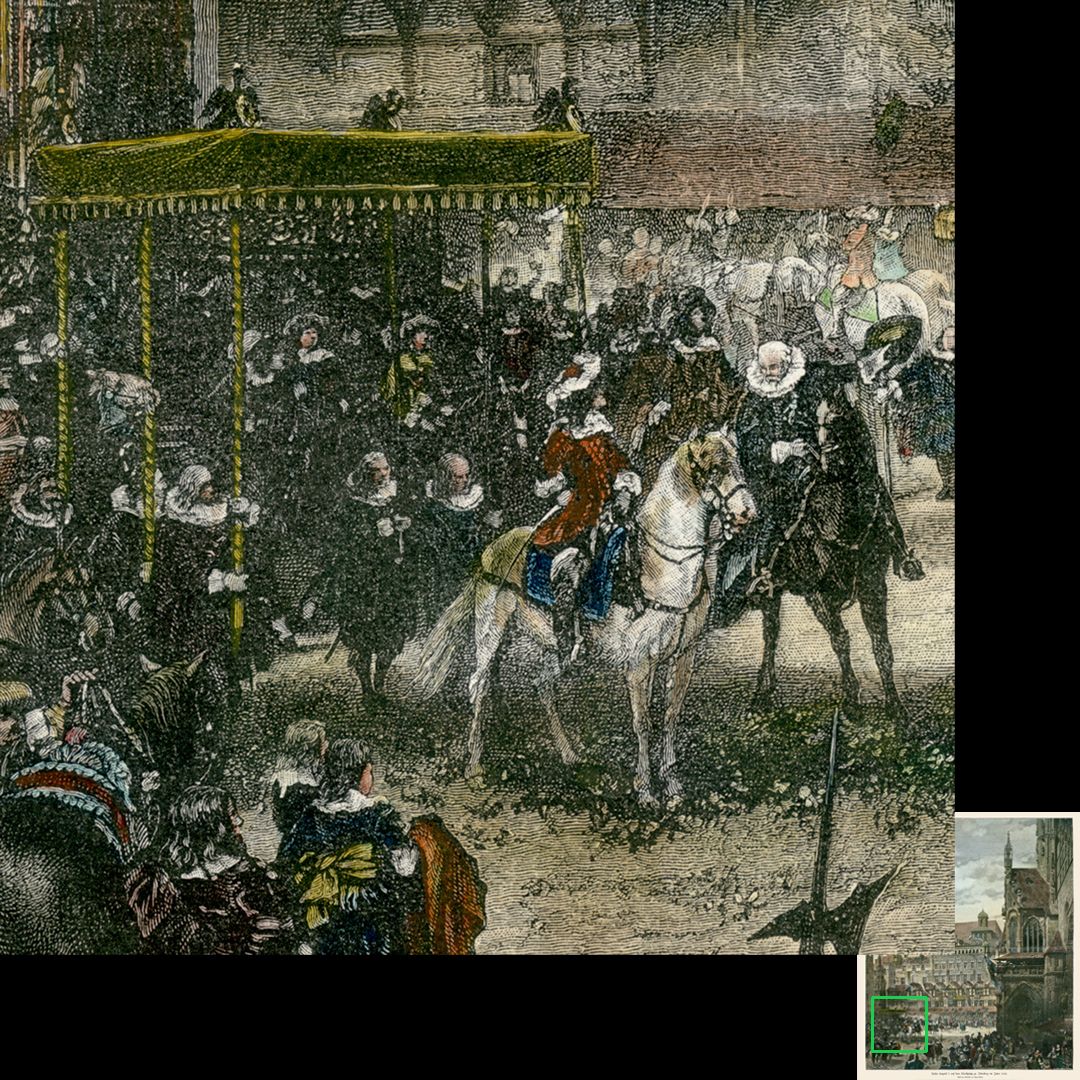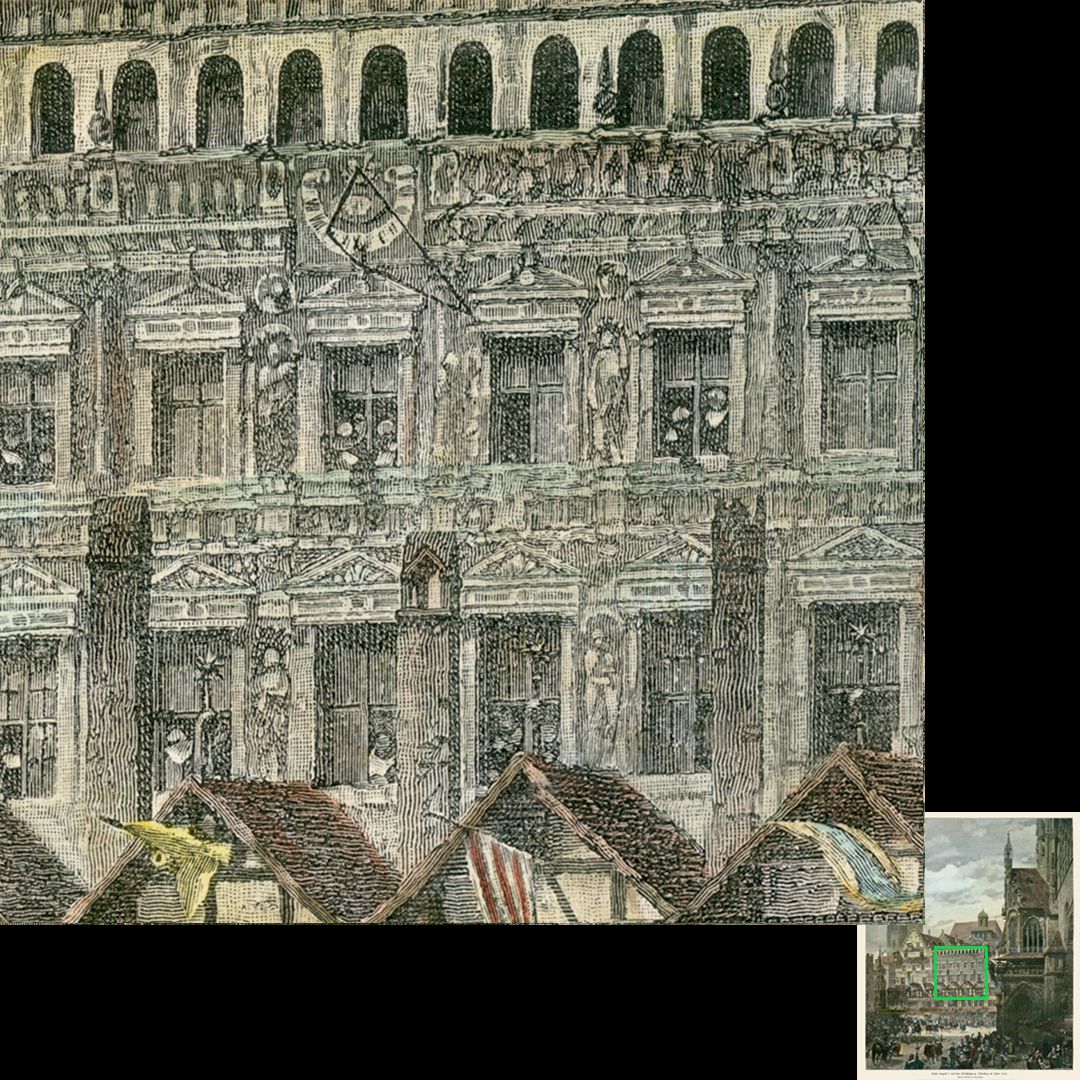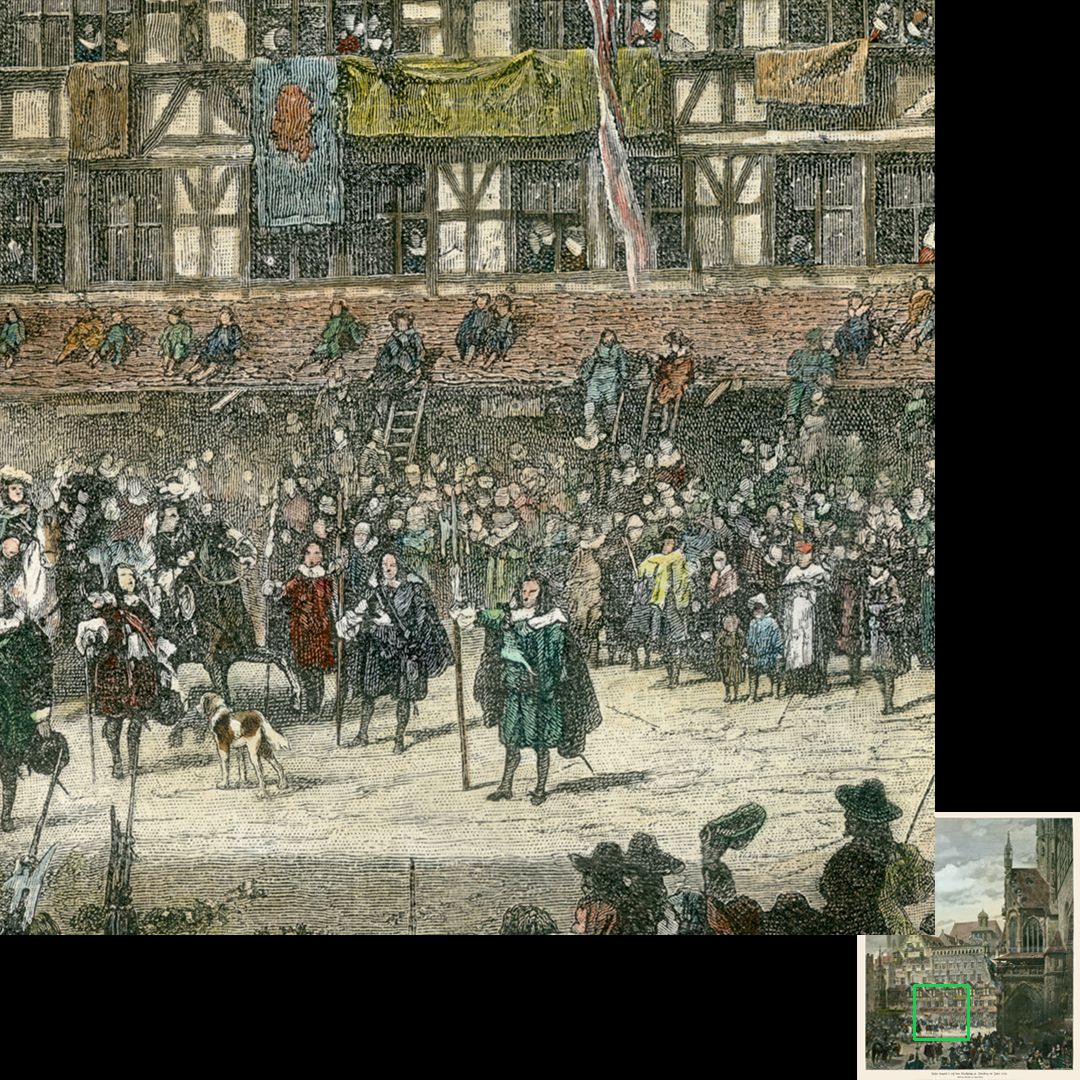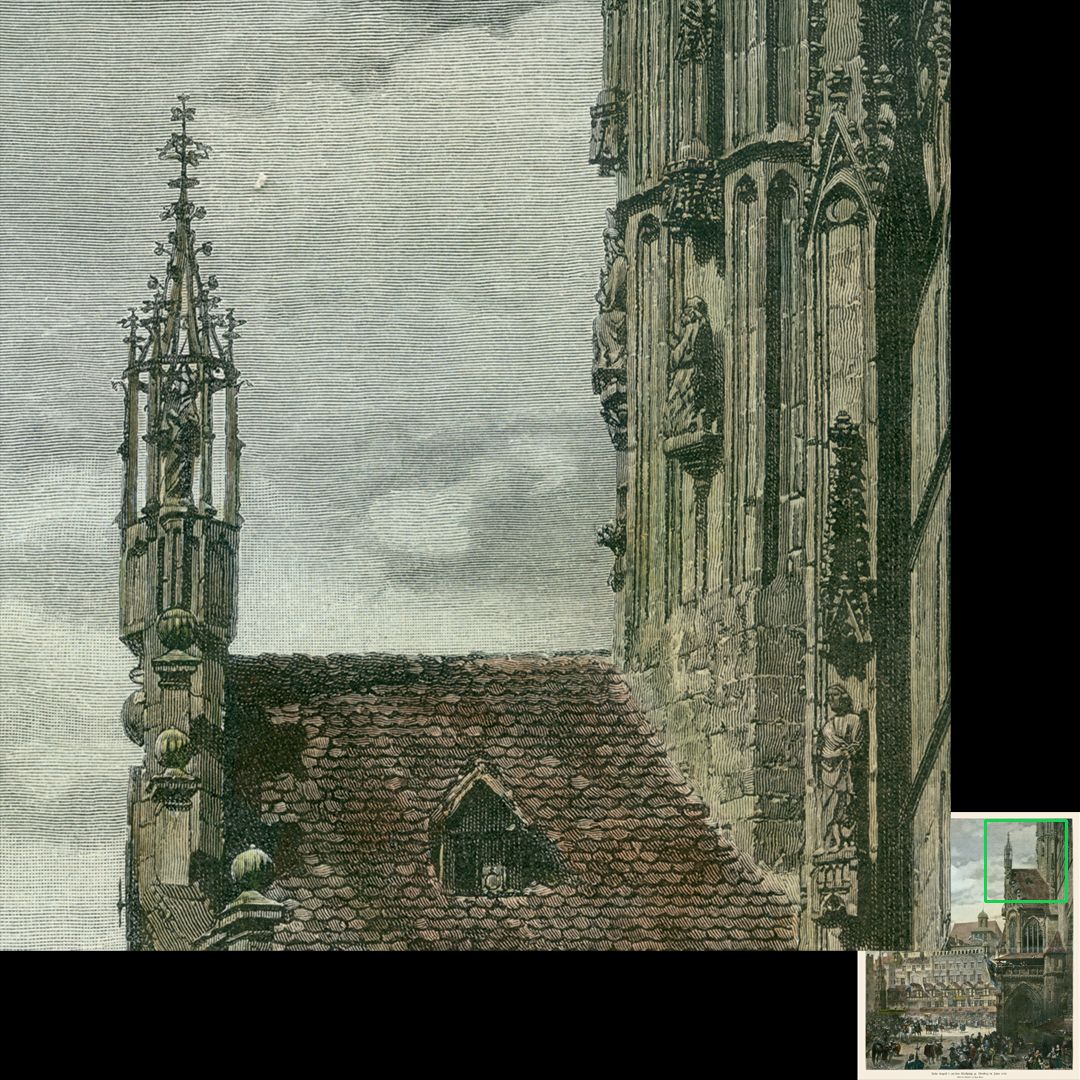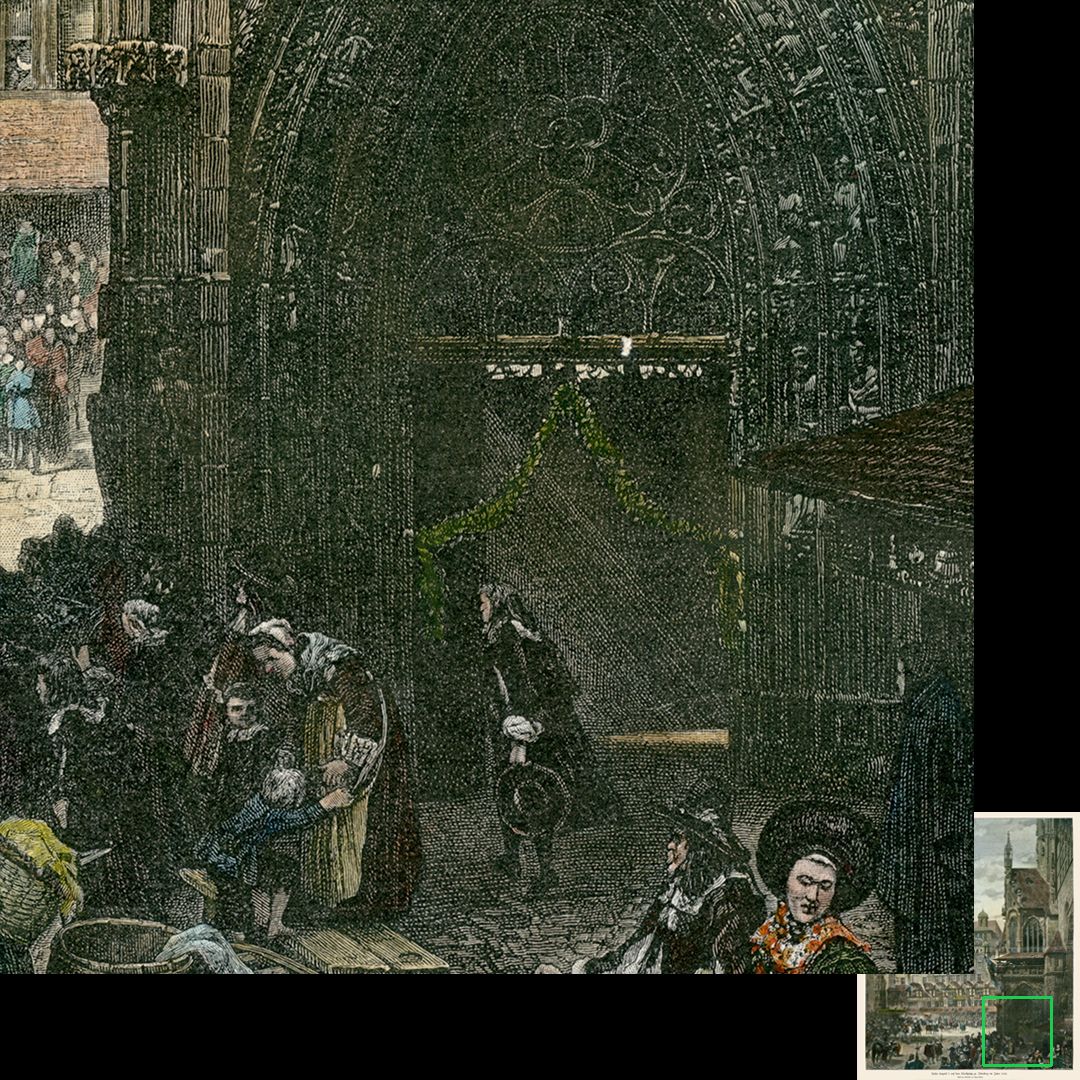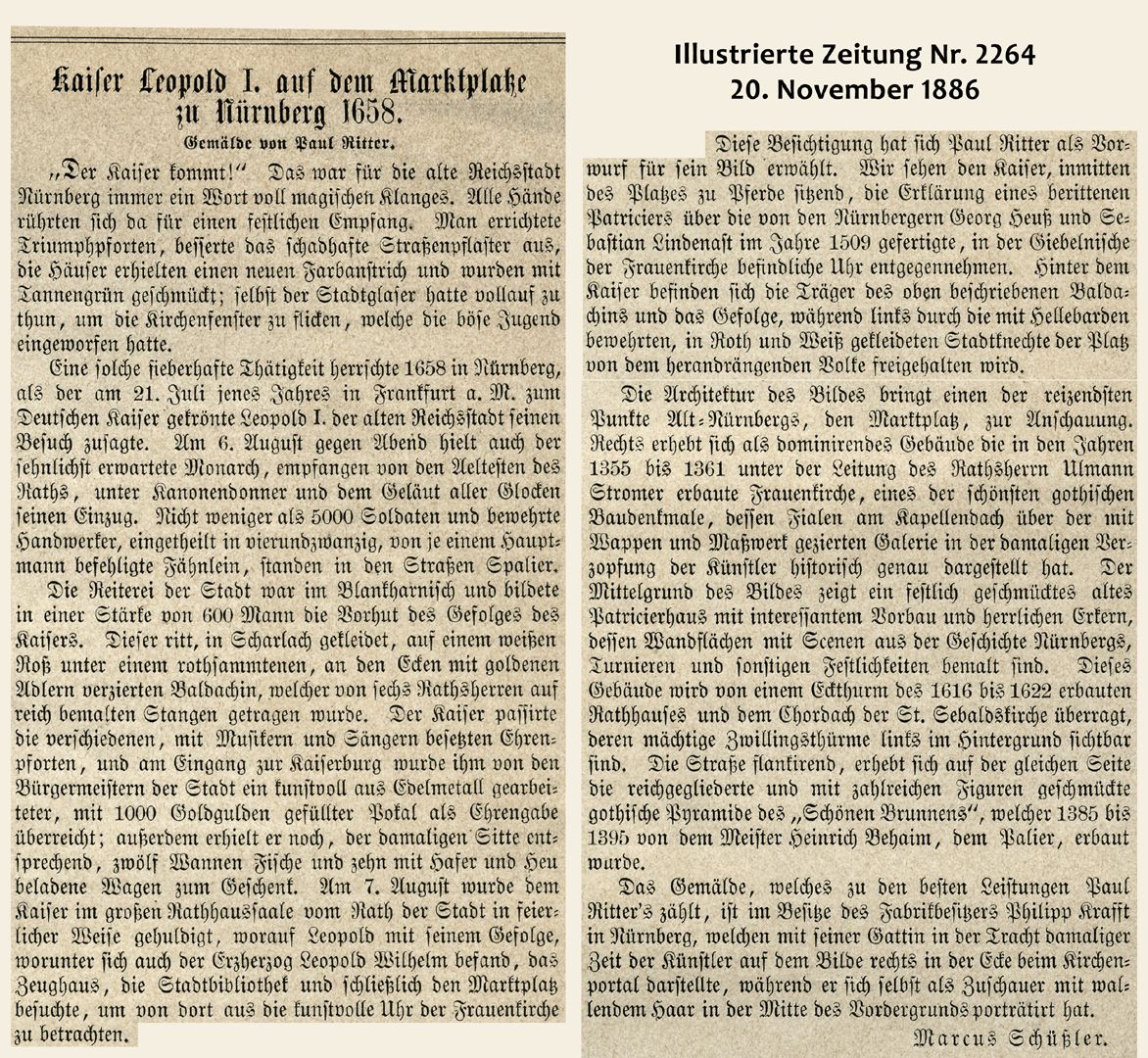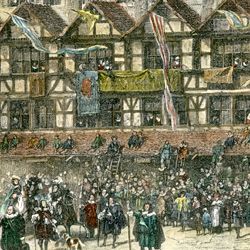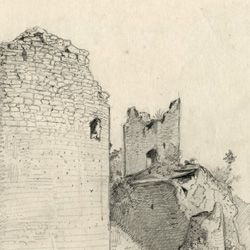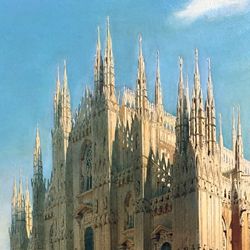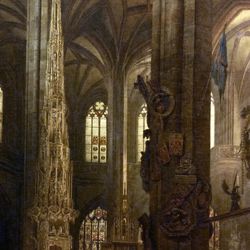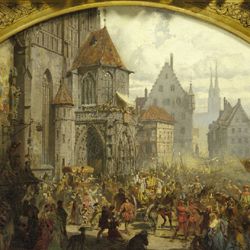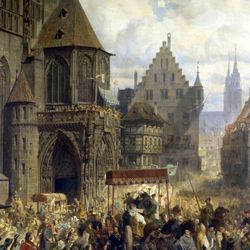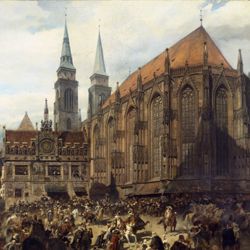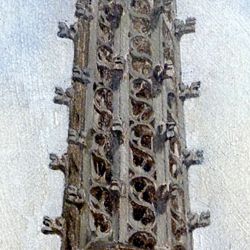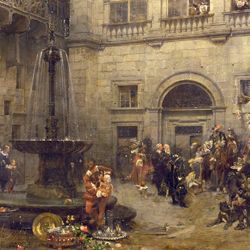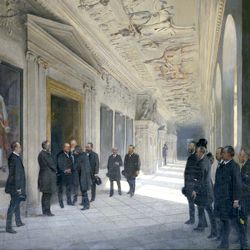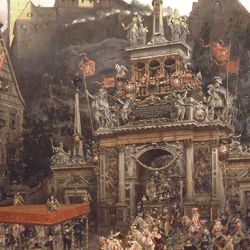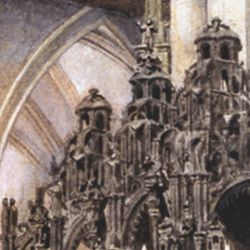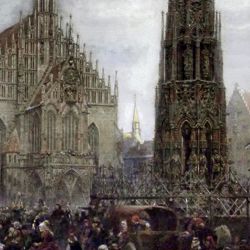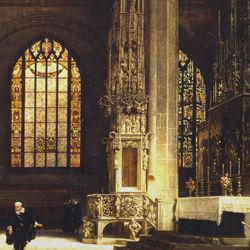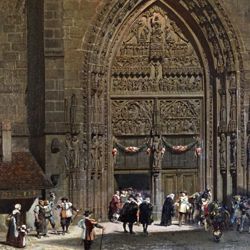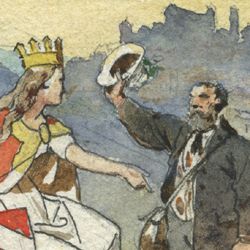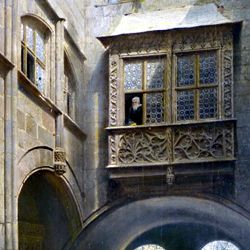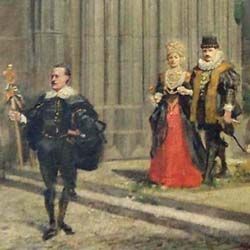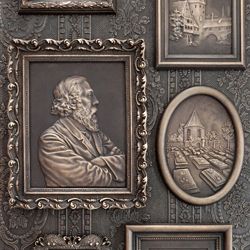Market Square in Nuremberg with Emperor Leopold's Entry in 1658
Market Square in Nuremberg with Emperor Leopold's Entry in 1658
1886
1846 apprenticeship as a wood engraver and 1847-53 attendance at the art school in Cologne.
Wood engraving after a painting by Paul Ritter from 1885.
Client of the painting: factory owner Philipp Krafft from Nuremberg (tobacco factory Theresienstr.7).
______________________________
The architectural backdrop of the painting is the Frauenkirche (Church of Our Lady) and, on the north side of the market square, Engelhard'sche Haus with the frescoes that were still there at the time. Above the aforementioned building, the towers of the town hall rise in the background, on the left edge of the picture the "Schöne Brunnen" can be seen and behind it the mighty towers of St. Sebald. On the market square stands Emperor Leopold I, who has just been mounted. Under a canopy carried by Nuremberg patricians, to look at the ornate clock of the Frauenkirche. The crowds are held back by the city servants dressed in white and red. Among the spectators, the artist has portrayed himself. In the right-hand corner of the picture, near the stalls of the Frauenkirche, the standing citizen is recognisable as the patron of the painting and his wife.
quoted from:
Paul Ritter and the Cultural-Historical Cityscape of Nuremberg in the Late 19th Century, p. 345.
Silke Colditz-Heusl
Location: private
Design: Ritter, Johann Paul d.Ä.
Realization: Brend’amour, Richard
Material: Wood engraving
scan 2020, Theo Noll
Market Square in Nuremberg with Emperor Leopold's Entry in 1658
1886
1846 apprenticeship as a wood engraver and 1847-53 attendance at the art school in Cologne.
Wood engraving after a painting by Paul Ritter from 1885.
Client of the painting: factory owner Philipp Krafft from Nuremberg (tobacco factory Theresienstr.7).
______________________________
The architectural backdrop of the painting is the Frauenkirche (Church of Our Lady) and, on the north side of the market square, Engelhard'sche Haus with the frescoes that were still there at the time. Above the aforementioned building, the towers of the town hall rise in the background, on the left edge of the picture the "Schöne Brunnen" can be seen and behind it the mighty towers of St. Sebald. On the market square stands Emperor Leopold I, who has just been mounted. Under a canopy carried by Nuremberg patricians, to look at the ornate clock of the Frauenkirche. The crowds are held back by the city servants dressed in white and red. Among the spectators, the artist has portrayed himself. In the right-hand corner of the picture, near the stalls of the Frauenkirche, the standing citizen is recognisable as the patron of the painting and his wife.
quoted from:
Paul Ritter and the Cultural-Historical Cityscape of Nuremberg in the Late 19th Century, p. 345.
Silke Colditz-Heusl
Location: private
Design: Ritter, Johann Paul d.Ä.
Realization: Brend’amour, Richard
Material: Wood engraving
photo 2020, Theo Noll
Market Square in Nuremberg with Emperor Leopold's Entry in 1658
1886
1846 apprenticeship as a wood engraver and 1847-53 attendance at the art school in Cologne.
Wood engraving after a painting by Paul Ritter from 1885.
Client of the painting: factory owner Philipp Krafft from Nuremberg (tobacco factory Theresienstr.7).
______________________________
The architectural backdrop of the painting is the Frauenkirche (Church of Our Lady) and, on the north side of the market square, Engelhard'sche Haus with the frescoes that were still there at the time. Above the aforementioned building, the towers of the town hall rise in the background, on the left edge of the picture the "Schöne Brunnen" can be seen and behind it the mighty towers of St. Sebald. On the market square stands Emperor Leopold I, who has just been mounted. Under a canopy carried by Nuremberg patricians, to look at the ornate clock of the Frauenkirche. The crowds are held back by the city servants dressed in white and red. Among the spectators, the artist has portrayed himself. In the right-hand corner of the picture, near the stalls of the Frauenkirche, the standing citizen is recognisable as the patron of the painting and his wife.
quoted from:
Paul Ritter and the Cultural-Historical Cityscape of Nuremberg in the Late 19th Century, p. 345.
Silke Colditz-Heusl
Location: private
Design: Ritter, Johann Paul d.Ä.
Realization: Brend’amour, Richard
Material: Wood engraving
photo 2020, Theo Noll
Market Square in Nuremberg with Emperor Leopold's Entry in 1658
1886
private
1846 apprenticeship as a wood engraver and 1847-53 attendance at the art school in Cologne.
Wood engraving after a painting by Paul Ritter from 1885.
Client of the painting: factory owner Philipp Krafft from Nuremberg (tobacco factory Theresienstr.7).
______________________________
The architectural backdrop of the painting is the Frauenkirche (Church of Our Lady) and, on the north side of the market square, Engelhard'sche Haus with the frescoes that were still there at the time. Above the aforementioned building, the towers of the town hall rise in the background, on the left edge of the picture the "Schöne Brunnen" can be seen and behind it the mighty towers of St. Sebald. On the market square stands Emperor Leopold I, who has just been mounted. Under a canopy carried by Nuremberg patricians, to look at the ornate clock of the Frauenkirche. The crowds are held back by the city servants dressed in white and red. Among the spectators, the artist has portrayed himself. In the right-hand corner of the picture, near the stalls of the Frauenkirche, the standing citizen is recognisable as the patron of the painting and his wife.
quoted from:
Paul Ritter and the Cultural-Historical Cityscape of Nuremberg in the Late 19th Century, p. 345.
Silke Colditz-Heusl
Location: privat
Design: Ritter, Johann Paul d.Ä.
Realization: Brend’amour, Richard
Material: Wood engraving
photo 2020, Theo Noll
Market Square in Nuremberg with Emperor Leopold's Entry in 1658
1886
1846 apprenticeship as a wood engraver and 1847-53 attendance at the art school in Cologne.
Wood engraving after a painting by Paul Ritter from 1885.
Client of the painting: factory owner Philipp Krafft from Nuremberg (tobacco factory Theresienstr.7).
______________________________
The architectural backdrop of the painting is the Frauenkirche (Church of Our Lady) and, on the north side of the market square, Engelhard'sche Haus with the frescoes that were still there at the time. Above the aforementioned building, the towers of the town hall rise in the background, on the left edge of the picture the "Schöne Brunnen" can be seen and behind it the mighty towers of St. Sebald. On the market square stands Emperor Leopold I, who has just been mounted. Under a canopy carried by Nuremberg patricians, to look at the ornate clock of the Frauenkirche. The crowds are held back by the city servants dressed in white and red. Among the spectators, the artist has portrayed himself. In the right-hand corner of the picture, near the stalls of the Frauenkirche, the standing citizen is recognisable as the patron of the painting and his wife.
quoted from:
Paul Ritter and the Cultural-Historical Cityscape of Nuremberg in the Late 19th Century, p. 345.
Silke Colditz-Heusl
Location: private
Design: Ritter, Johann Paul d.Ä.
Realization: Brend’amour, Richard
Material: Wood engraving
photo 2020, Theo Noll
Market Square in Nuremberg with Emperor Leopold's Entry in 1658
1886
1846 apprenticeship as a wood engraver and 1847-53 attendance at the art school in Cologne.
Wood engraving after a painting by Paul Ritter from 1885.
Client of the painting: factory owner Philipp Krafft from Nuremberg (tobacco factory Theresienstr.7).
______________________________
The architectural backdrop of the painting is the Frauenkirche (Church of Our Lady) and, on the north side of the market square, Engelhard'sche Haus with the frescoes that were still there at the time. Above the aforementioned building, the towers of the town hall rise in the background, on the left edge of the picture the "Schöne Brunnen" can be seen and behind it the mighty towers of St. Sebald. On the market square stands Emperor Leopold I, who has just been mounted. Under a canopy carried by Nuremberg patricians, to look at the ornate clock of the Frauenkirche. The crowds are held back by the city servants dressed in white and red. Among the spectators, the artist has portrayed himself. In the right-hand corner of the picture, near the stalls of the Frauenkirche, the standing citizen is recognisable as the patron of the painting and his wife.
quoted from:
Paul Ritter and the Cultural-Historical Cityscape of Nuremberg in the Late 19th Century, p. 345.
Silke Colditz-Heusl
Location: private
Design: Ritter, Johann Paul d.Ä.
Realization: Brend’amour, Richard
Material: Wood engraving
photo 2020, Theo Noll
Market Square in Nuremberg with Emperor Leopold's Entry in 1658
1886
Paul Ritter with "flowing hair" in the foreground of the picture
1846 apprenticeship as a wood engraver and 1847-53 attendance at the art school in Cologne.
Wood engraving after a painting by Paul Ritter from 1885.
Client of the painting: factory owner Philipp Krafft from Nuremberg (tobacco factory Theresienstr.7).
______________________________
The architectural backdrop of the painting is the Frauenkirche (Church of Our Lady) and, on the north side of the market square, Engelhard'sche Haus with the frescoes that were still there at the time. Above the aforementioned building, the towers of the town hall rise in the background, on the left edge of the picture the "Schöne Brunnen" can be seen and behind it the mighty towers of St. Sebald. On the market square stands Emperor Leopold I, who has just been mounted. Under a canopy carried by Nuremberg patricians, to look at the ornate clock of the Frauenkirche. The crowds are held back by the city servants dressed in white and red. Among the spectators, the artist has portrayed himself. In the right-hand corner of the picture, near the stalls of the Frauenkirche, the standing citizen is recognisable as the patron of the painting and his wife.
quoted from:
Paul Ritter and the Cultural-Historical Cityscape of Nuremberg in the Late 19th Century, p. 345.
Silke Colditz-Heusl
Location: private
Design: Ritter, Johann Paul d.Ä.
Realization: Brend’amour, Richard
Material: Wood engraving
photo 2020, Theo Noll
Market Square in Nuremberg with Emperor Leopold's Entry in 1658
1886
The owner of the painting, Philipp Krafft and his wife / below the signature of Richard Brend'amour's Xylographische Anstalt.
1846 apprenticeship as a wood engraver and 1847-53 attendance at the art school in Cologne.
Wood engraving after a painting by Paul Ritter from 1885.
Client of the painting: factory owner Philipp Krafft from Nuremberg (tobacco factory Theresienstr.7).
______________________________
The architectural backdrop of the painting is the Frauenkirche (Church of Our Lady) and, on the north side of the market square, Engelhard'sche Haus with the frescoes that were still there at the time. Above the aforementioned building, the towers of the town hall rise in the background, on the left edge of the picture the "Schöne Brunnen" can be seen and behind it the mighty towers of St. Sebald. On the market square stands Emperor Leopold I, who has just been mounted. Under a canopy carried by Nuremberg patricians, to look at the ornate clock of the Frauenkirche. The crowds are held back by the city servants dressed in white and red. Among the spectators, the artist has portrayed himself. In the right-hand corner of the picture, near the stalls of the Frauenkirche, the standing citizen is recognisable as the patron of the painting and his wife.
quoted from:
Paul Ritter and the Cultural-Historical Cityscape of Nuremberg in the Late 19th Century, p. 345.
Silke Colditz-Heusl
Location: private
Design: Ritter, Johann Paul d.Ä.
Realization: Brend’amour, Richard
Material: Wood engraving
photo 2020, Theo Noll
Market Square in Nuremberg with Emperor Leopold's Entry in 1658
1886
Lower left corner of the picture with the signature of Paul Ritter
1846 apprenticeship as a wood engraver and 1847-53 attendance at the art school in Cologne.
Wood engraving after a painting by Paul Ritter from 1885.
Client of the painting: factory owner Philipp Krafft from Nuremberg (tobacco factory Theresienstr.7).
______________________________
The architectural backdrop of the painting is the Frauenkirche (Church of Our Lady) and, on the north side of the market square, Engelhard'sche Haus with the frescoes that were still there at the time. Above the aforementioned building, the towers of the town hall rise in the background, on the left edge of the picture the "Schöne Brunnen" can be seen and behind it the mighty towers of St. Sebald. On the market square stands Emperor Leopold I, who has just been mounted. Under a canopy carried by Nuremberg patricians, to look at the ornate clock of the Frauenkirche. The crowds are held back by the city servants dressed in white and red. Among the spectators, the artist has portrayed himself. In the right-hand corner of the picture, near the stalls of the Frauenkirche, the standing citizen is recognisable as the patron of the painting and his wife.
quoted from:
Paul Ritter and the Cultural-Historical Cityscape of Nuremberg in the Late 19th Century, p. 345.
Silke Colditz-Heusl
Location: private
Design: Ritter, Johann Paul d.Ä.
Realization: Brend’amour, Richard
Material: Wood engraving
photo 2020, Theo Noll
Market Square in Nuremberg with Emperor Leopold's Entry in 1658
1886
1846 apprenticeship as a wood engraver and 1847-53 attendance at the art school in Cologne.
Wood engraving after a painting by Paul Ritter from 1885.
Client of the painting: factory owner Philipp Krafft from Nuremberg (tobacco factory Theresienstr.7).
______________________________
The architectural backdrop of the painting is the Frauenkirche (Church of Our Lady) and, on the north side of the market square, Engelhard'sche Haus with the frescoes that were still there at the time. Above the aforementioned building, the towers of the town hall rise in the background, on the left edge of the picture the "Schöne Brunnen" can be seen and behind it the mighty towers of St. Sebald. On the market square stands Emperor Leopold I, who has just been mounted. Under a canopy carried by Nuremberg patricians, to look at the ornate clock of the Frauenkirche. The crowds are held back by the city servants dressed in white and red. Among the spectators, the artist has portrayed himself. In the right-hand corner of the picture, near the stalls of the Frauenkirche, the standing citizen is recognisable as the patron of the painting and his wife.
quoted from:
Paul Ritter and the Cultural-Historical Cityscape of Nuremberg in the Late 19th Century, p. 345.
Silke Colditz-Heusl
Location: private
Design: Ritter, Johann Paul d.Ä.
Realization: Brend’amour, Richard
Material: Wood engraving
photo 2020, Theo Noll
Market Square in Nuremberg with Emperor Leopold's Entry in 1658
1886
1846 apprenticeship as a wood engraver and 1847-53 attendance at the art school in Cologne.
Wood engraving after a painting by Paul Ritter from 1885.
Client of the painting: factory owner Philipp Krafft from Nuremberg (tobacco factory Theresienstr.7).
______________________________
The architectural backdrop of the painting is the Frauenkirche (Church of Our Lady) and, on the north side of the market square, Engelhard'sche Haus with the frescoes that were still there at the time. Above the aforementioned building, the towers of the town hall rise in the background, on the left edge of the picture the "Schöne Brunnen" can be seen and behind it the mighty towers of St. Sebald. On the market square stands Emperor Leopold I, who has just been mounted. Under a canopy carried by Nuremberg patricians, to look at the ornate clock of the Frauenkirche. The crowds are held back by the city servants dressed in white and red. Among the spectators, the artist has portrayed himself. In the right-hand corner of the picture, near the stalls of the Frauenkirche, the standing citizen is recognisable as the patron of the painting and his wife.
quoted from:
Paul Ritter and the Cultural-Historical Cityscape of Nuremberg in the Late 19th Century, p. 345.
Silke Colditz-Heusl
Location: private
Design: Ritter, Johann Paul d.Ä.
Realization: Brend’amour, Richard
Material: Wood engraving
photo 2020, Theo Noll
Market Square in Nuremberg with Emperor Leopold's Entry in 1658
1886
1846 apprenticeship as a wood engraver and 1847-53 attendance at the art school in Cologne.
Wood engraving after a painting by Paul Ritter from 1885.
Client of the painting: factory owner Philipp Krafft from Nuremberg (tobacco factory Theresienstr.7).
______________________________
The architectural backdrop of the painting is the Frauenkirche (Church of Our Lady) and, on the north side of the market square, Engelhard'sche Haus with the frescoes that were still there at the time. Above the aforementioned building, the towers of the town hall rise in the background, on the left edge of the picture the "Schöne Brunnen" can be seen and behind it the mighty towers of St. Sebald. On the market square stands Emperor Leopold I, who has just been mounted. Under a canopy carried by Nuremberg patricians, to look at the ornate clock of the Frauenkirche. The crowds are held back by the city servants dressed in white and red. Among the spectators, the artist has portrayed himself. In the right-hand corner of the picture, near the stalls of the Frauenkirche, the standing citizen is recognisable as the patron of the painting and his wife.
quoted from:
Paul Ritter and the Cultural-Historical Cityscape of Nuremberg in the Late 19th Century, p. 345.
Silke Colditz-Heusl
Location: private
Design: Ritter, Johann Paul d.Ä.
Realization: Brend’amour, Richard
Material: Wood engraving
photo 2020, Theo Noll
Market Square in Nuremberg with Emperor Leopold's Entry in 1658
1886
1846 apprenticeship as a wood engraver and 1847-53 attendance at the art school in Cologne.
Wood engraving after a painting by Paul Ritter from 1885.
Client of the painting: factory owner Philipp Krafft from Nuremberg (tobacco factory Theresienstr.7).
______________________________
The architectural backdrop of the painting is the Frauenkirche (Church of Our Lady) and, on the north side of the market square, Engelhard'sche Haus with the frescoes that were still there at the time. Above the aforementioned building, the towers of the town hall rise in the background, on the left edge of the picture the "Schöne Brunnen" can be seen and behind it the mighty towers of St. Sebald. On the market square stands Emperor Leopold I, who has just been mounted. Under a canopy carried by Nuremberg patricians, to look at the ornate clock of the Frauenkirche. The crowds are held back by the city servants dressed in white and red. Among the spectators, the artist has portrayed himself. In the right-hand corner of the picture, near the stalls of the Frauenkirche, the standing citizen is recognisable as the patron of the painting and his wife.
quoted from:
Paul Ritter and the Cultural-Historical Cityscape of Nuremberg in the Late 19th Century, p. 345.
Silke Colditz-Heusl
Location: private
Design: Ritter, Johann Paul d.Ä.
Realization: Brend’amour, Richard
Material: Wood engraving
photo 2020, Theo Noll
Market Square in Nuremberg with Emperor Leopold's Entry in 1658
1886
1846 apprenticeship as a wood engraver and 1847-53 attendance at the art school in Cologne.
Wood engraving after a painting by Paul Ritter from 1885.
Client of the painting: factory owner Philipp Krafft from Nuremberg (tobacco factory Theresienstr.7).
______________________________
The architectural backdrop of the painting is the Frauenkirche (Church of Our Lady) and, on the north side of the market square, Engelhard'sche Haus with the frescoes that were still there at the time. Above the aforementioned building, the towers of the town hall rise in the background, on the left edge of the picture the "Schöne Brunnen" can be seen and behind it the mighty towers of St. Sebald. On the market square stands Emperor Leopold I, who has just been mounted. Under a canopy carried by Nuremberg patricians, to look at the ornate clock of the Frauenkirche. The crowds are held back by the city servants dressed in white and red. Among the spectators, the artist has portrayed himself. In the right-hand corner of the picture, near the stalls of the Frauenkirche, the standing citizen is recognisable as the patron of the painting and his wife.
quoted from:
Paul Ritter and the Cultural-Historical Cityscape of Nuremberg in the Late 19th Century, p. 345.
Silke Colditz-Heusl
Location: private
Design: Ritter, Johann Paul d.Ä.
Realization: Brend’amour, Richard
Material: Wood engraving
photo 2020, Theo Noll
Market Square in Nuremberg with Emperor Leopold's Entry in 1658
1886
1846 apprenticeship as a wood engraver and 1847-53 attendance at the art school in Cologne.
Wood engraving after a painting by Paul Ritter from 1885.
Client of the painting: factory owner Philipp Krafft from Nuremberg (tobacco factory Theresienstr.7).
______________________________
The architectural backdrop of the painting is the Frauenkirche (Church of Our Lady) and, on the north side of the market square, Engelhard'sche Haus with the frescoes that were still there at the time. Above the aforementioned building, the towers of the town hall rise in the background, on the left edge of the picture the "Schöne Brunnen" can be seen and behind it the mighty towers of St. Sebald. On the market square stands Emperor Leopold I, who has just been mounted. Under a canopy carried by Nuremberg patricians, to look at the ornate clock of the Frauenkirche. The crowds are held back by the city servants dressed in white and red. Among the spectators, the artist has portrayed himself. In the right-hand corner of the picture, near the stalls of the Frauenkirche, the standing citizen is recognisable as the patron of the painting and his wife.
quoted from:
Paul Ritter and the Cultural-Historical Cityscape of Nuremberg in the Late 19th Century, p. 345.
Silke Colditz-Heusl
Location: private
Design: Ritter, Johann Paul d.Ä.
Realization: Brend’amour, Richard
Material: Wood engraving
photo 2020, Theo Noll
Market Square in Nuremberg with Emperor Leopold's Entry in 1658
1886
1846 apprenticeship as a wood engraver and 1847-53 attendance at the art school in Cologne.
Wood engraving after a painting by Paul Ritter from 1885.
Client of the painting: factory owner Philipp Krafft from Nuremberg (tobacco factory Theresienstr.7).
______________________________
The architectural backdrop of the painting is the Frauenkirche (Church of Our Lady) and, on the north side of the market square, Engelhard'sche Haus with the frescoes that were still there at the time. Above the aforementioned building, the towers of the town hall rise in the background, on the left edge of the picture the "Schöne Brunnen" can be seen and behind it the mighty towers of St. Sebald. On the market square stands Emperor Leopold I, who has just been mounted. Under a canopy carried by Nuremberg patricians, to look at the ornate clock of the Frauenkirche. The crowds are held back by the city servants dressed in white and red. Among the spectators, the artist has portrayed himself. In the right-hand corner of the picture, near the stalls of the Frauenkirche, the standing citizen is recognisable as the patron of the painting and his wife.
quoted from:
Paul Ritter and the Cultural-Historical Cityscape of Nuremberg in the Late 19th Century, p. 345.
Silke Colditz-Heusl
Location: private
Design: Ritter, Johann Paul d.Ä.
Realization: Brend’amour, Richard
Material: Wood engraving
photo 2020, Theo Noll
Market Square in Nuremberg with Emperor Leopold's Entry in 1658
1886
1846 apprenticeship as a wood engraver and 1847-53 attendance at the art school in Cologne.
Wood engraving after a painting by Paul Ritter from 1885.
Client of the painting: factory owner Philipp Krafft from Nuremberg (tobacco factory Theresienstr.7).
______________________________
The architectural backdrop of the painting is the Frauenkirche (Church of Our Lady) and, on the north side of the market square, Engelhard'sche Haus with the frescoes that were still there at the time. Above the aforementioned building, the towers of the town hall rise in the background, on the left edge of the picture the "Schöne Brunnen" can be seen and behind it the mighty towers of St. Sebald. On the market square stands Emperor Leopold I, who has just been mounted. Under a canopy carried by Nuremberg patricians, to look at the ornate clock of the Frauenkirche. The crowds are held back by the city servants dressed in white and red. Among the spectators, the artist has portrayed himself. In the right-hand corner of the picture, near the stalls of the Frauenkirche, the standing citizen is recognisable as the patron of the painting and his wife.
quoted from:
Paul Ritter and the Cultural-Historical Cityscape of Nuremberg in the Late 19th Century, p. 345.
Silke Colditz-Heusl
Location: private
Design: Ritter, Johann Paul d.Ä.
Realization: Brend’amour, Richard
Material: Wood engraving
photo 2020, Theo Noll
Market Square in Nuremberg with Emperor Leopold's Entry in 1658
1886
1846 apprenticeship as a wood engraver and 1847-53 attendance at the art school in Cologne.
Wood engraving after a painting by Paul Ritter from 1885.
Client of the painting: factory owner Philipp Krafft from Nuremberg (tobacco factory Theresienstr.7).
______________________________
The architectural backdrop of the painting is the Frauenkirche (Church of Our Lady) and, on the north side of the market square, Engelhard'sche Haus with the frescoes that were still there at the time. Above the aforementioned building, the towers of the town hall rise in the background, on the left edge of the picture the "Schöne Brunnen" can be seen and behind it the mighty towers of St. Sebald. On the market square stands Emperor Leopold I, who has just been mounted. Under a canopy carried by Nuremberg patricians, to look at the ornate clock of the Frauenkirche. The crowds are held back by the city servants dressed in white and red. Among the spectators, the artist has portrayed himself. In the right-hand corner of the picture, near the stalls of the Frauenkirche, the standing citizen is recognisable as the patron of the painting and his wife.
quoted from:
Paul Ritter and the Cultural-Historical Cityscape of Nuremberg in the Late 19th Century, p. 345.
Silke Colditz-Heusl
Location: private
Design: Ritter, Johann Paul d.Ä.
Realization: Brend’amour, Richard
Material: Wood engraving
photo 2020, Theo Noll
Market Square in Nuremberg with Emperor Leopold's Entry in 1658
1886
1846 apprenticeship as a wood engraver and 1847-53 attendance at the art school in Cologne.
Wood engraving after a painting by Paul Ritter from 1885.
Client of the painting: factory owner Philipp Krafft from Nuremberg (tobacco factory Theresienstr.7).
______________________________
The architectural backdrop of the painting is the Frauenkirche (Church of Our Lady) and, on the north side of the market square, Engelhard'sche Haus with the frescoes that were still there at the time. Above the aforementioned building, the towers of the town hall rise in the background, on the left edge of the picture the "Schöne Brunnen" can be seen and behind it the mighty towers of St. Sebald. On the market square stands Emperor Leopold I, who has just been mounted. Under a canopy carried by Nuremberg patricians, to look at the ornate clock of the Frauenkirche. The crowds are held back by the city servants dressed in white and red. Among the spectators, the artist has portrayed himself. In the right-hand corner of the picture, near the stalls of the Frauenkirche, the standing citizen is recognisable as the patron of the painting and his wife.
quoted from:
Paul Ritter and the Cultural-Historical Cityscape of Nuremberg in the Late 19th Century, p. 345.
Silke Colditz-Heusl
Location: private
Design: Ritter, Johann Paul d.Ä.
Realization: Brend’amour, Richard
Material: Wood engraving
photo 2020, Theo Noll
Market Square in Nuremberg with Emperor Leopold's Entry in 1658
1886
Description of the wood engraving in the Illustrierte Zeitung 1886
1846 apprenticeship as a wood engraver and 1847-53 attendance at the art school in Cologne.
Wood engraving after a painting by Paul Ritter from 1885.
Client of the painting: factory owner Philipp Krafft from Nuremberg (tobacco factory Theresienstr.7).
______________________________
The architectural backdrop of the painting is the Frauenkirche (Church of Our Lady) and, on the north side of the market square, Engelhard'sche Haus with the frescoes that were still there at the time. Above the aforementioned building, the towers of the town hall rise in the background, on the left edge of the picture the "Schöne Brunnen" can be seen and behind it the mighty towers of St. Sebald. On the market square stands Emperor Leopold I, who has just been mounted. Under a canopy carried by Nuremberg patricians, to look at the ornate clock of the Frauenkirche. The crowds are held back by the city servants dressed in white and red. Among the spectators, the artist has portrayed himself. In the right-hand corner of the picture, near the stalls of the Frauenkirche, the standing citizen is recognisable as the patron of the painting and his wife.
quoted from:
Paul Ritter and the Cultural-Historical Cityscape of Nuremberg in the Late 19th Century, p. 345.
Silke Colditz-Heusl
Location: private
Design: Ritter, Johann Paul d.Ä.
Realization: Brend’amour, Richard
Material: Wood engraving
scan 2020, Theo Noll
